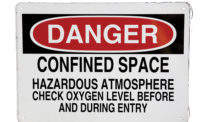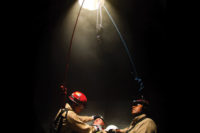Trying to decide if you need an on-site rescue team for your confined space work?
What does the law say? OSHA regulation 29 CFR 1910.146 outlines several requirements of a rescue team that include: proficiency with skills, equipment, CPR/first-aid certification, etc. On the surface this sounds like your local fire department, and it would appear to be the perfect solution to serve as your confined space rescue team.
But not so fast. OSHA’s standard 29 CFR 1910.146(k)(1)(iii)(A) says that a rescue team:
“Has the capability to reach the victim(s) within a time frame that is appropriate for the permit space hazard(s) identified.”
This can leave you with more questions than answers.
What is an “appropriate time frame for the hazards identified” as referenced in the OSHA regulation?
NFPA 350 standard
Close the book of OSHA standards, and open your copy of NFPA 350: Guide for Safe Confined Space Entry and Work. NFPA 350 does not use the language “permit required confined spaces.” Instead, it defines confined spaces with hazards and those without. OSHA regulations will generally tell you what to do; NFPA standards give you a lot more information, and tell you how to do it.
NFPA 350 defines rescue response modes for confined spaces as Tier 1, Tier 2, or Tier 3. Tier 2 and Tier 3 responses would apply to those spaces OSHA defines as a permit required confined space. OSHA considers a permit required space one that has one or more of the following:
- Contains or has a potential to contain a hazardous atmosphere;
- Contains a material that has the potential for engulfing an entrant;
- Has an internal configuration such that an entrant could be trapped or asphyxiated by inwardly converging walls or by a floor which slopes downward and tapers to a smaller cross-section; or
- Contains any other recognized serious safety or health hazard.
These are hazards that can incapacitate an entrant, and require rescue. So now that we have established what the response tier is for the space, what are the rescue team requirements?
Tier responses
NFPA 350 chapter 10.1.3.4.2 states that for a Tier 2 response: “a full trained rescue team meeting NFPA 1670… is on site with appropriate capability to make safe entry for rescue. The team should be equipped and mobile and capable of setup and rescue entry within 12-15 minutes of incident occurrence.”
A Tier 3 response is indicated if an IDLH atmosphere or any other actual or potential life-threatening hazard exists within the space. Tier 3 response teams must also be trained to the technician level. NFPA 350 chapter 10.1.3.4.3 says: “This team should be completely set up and capable of rescue entry within two minutes of incident occurrence.”
This means that if an entrant becomes incapacitated the rescue team is entering the space two minutes after the entrant goes down.
Questions for your local fire department
Let’s revisit a plan to use the local municipal fire department for rescue. First, no fire department would meet the requirement of being onsite, but can they make rescue entry within 12-15 minutes from their fire station?
How far is your facility from the nearest fire station?
Most fire stations are expected to arrive on the scene of an emergency within six minutes of receiving the call for help. But not all firefighters are trained or equipped for the complex environment of confined space rescue.
Is your closest fire station available?
What happens if the closest fire station is already tending to another emergency call? Response time standards account for this, and allow for longer response times when multiple emergencies have occurred. This could extend to eight or ten minutes the time for 911 responders to arrive.
How quickly can confined space rescue technician trained firefighters arrive?
Once firefighters arrive, they need to size up the situation and request units with confined space rescue training and equipment. According to NFPA 1670 annex A, which applies to the fire department’s team, “The rescue service should have a goal of responding to these emergencies within 15 minutes of the time they receive notification.” This alone could put the 911 response beyond the 12 – 15 minutes that NFPA 350 allocates for Tier 1 and Tier 2 responses.
A typical municipal response
Once at the scene, firefighters must assess the scene, complete an entry permit, monitor the air, ensure lockout/tagout, ventilate the space, create a rescue plan, set up their rigging and retrieval system, and make entry. Is this list of tasks achievable in 12-15 minutes from incident occurrence? No.
It’s nearly impossible to meet the NFPA 350 Confined Space standard by relying on your local fire department for rescue. To meet the industry standards, and ensure the safety of your workers, a dedicated on-site rescue team is a must. Anything else is an attempt to check a box.



